商务谈判复习提纲
2024年商务谈判提纲总结(2篇)

2024年商务谈判提纲总结一、引言- 介绍参与商务谈判的各方背景和目标- 强调商务谈判的重要性和目的二、问题定义- 确定商务谈判的核心问题和争议点- 分析相关市场趋势和竞争环境,预测未来发展动态三、利益分析- 评估各方利益,并确定共同利益的基础- 分析可能的合作机会和风险四、谈判策略- 确定谈判目标和优先级- 制定谈判策略和计划,包括信息收集、团队准备等方面五、谈判准备- 收集必要的信息和数据,包括市场分析、法律和政策规定等- 研究对方背景和谈判代表的偏好和风格六、建立信任- 运用积极的沟通技巧和心态,建立起互信关系- 基于互利互惠原则,寻找合作可能性七、提出建议- 在谈判过程中提出切实可行的解决方案- 强调双方共同利益,推动谈判进程八、讨论具体合作细节- 就合作方式、资源共享、责任分工等进行讨论- 确定合作细节的具体规定和条款九、解决争端- 针对可能出现的争端,制定解决方案并进行协商- 寻求双方都能接受的解决办法,维护合作关系十、协议达成与签署- 商定合作方案的最终版本并进行签署- 确定双方履行合作协议的具体步骤和时间表十一、后续跟进- 确保合作协议的有效履行- 建立合作关系的长期机制和沟通渠道结语- 总结商务谈判的成果和经验教训- 展望未来合作的发展和潜力以上提纲仅供参考,具体商务谈判的内容和提纲可以根据实际情况进行调整和补充。
2024年商务谈判提纲总结(2)虽然本次商务谈判专周实训仅为期四天,但是其实在这次专周之前我们就用了两次课的时间来进行谈判题目抽选、组队和初步的资料收集。
专周的第一天,主要有三个任务,首先是老师对本次专周的内容安排和要求等作出介绍。
第二个任务就是每个队要给自己的队伍取一个名字,要有成员明确的分工,队伍理念和队伍口号。
我们小组名叫做:梦之队,小组分工也明确,我扮演财务顾问的角色。
我们的口号是:为维护球员权益而战!我们的理念是:维护球员权益,保障劳工合同!第三个任务就是观看上午用餐礼仪和模拟商务谈判视频。
商务谈判教学复习提要

商务谈判教学复习提要
第一单元商务谈判概论
一、重点掌握的内容
(一)概念部分
1.国际商务谈判的定义,即三个层次
2.国际商务谈判的构成,即三要素。
3.国际商务谈判的分类,即四种分类方法,共计14类的含义。
(二)操作部分
1.鉴别“国际商务”的五个标准:经济、司法、地域、引用(国际惯例或协议)、自主原则
2.国际商务谈判与国内商务谈判、外交谈判、人际交往的区别,主要学习本单元小结中第二段关于差异中的特征对比表。
3.标的分类(横面的)及三类标的谈判特征(普遍的——
共性的特征和各类特有的特征)。
二.一般掌握的内容
(一)概念部分
1.台上谈判人员和台下谈判人员的构成及各自和职责。
即:主谈人、负责人、助手、台下的领导及辅助人员的地位和责任。
2.经济背景中,国际市场所占的地位:垄断地位、供大于求、求大于供、供求平衡。
3.各类谈判(14种谈判)的不同谈判特征。
(二)操作部分
1.当主谈人和负责人两者分离时如何配合?当两者合一时,对谈判手的要求?
2.对单兵谈判的谈判手如何要求?
3.对意向书与协议书谈判应掌握的本质问题?
4.索赔谈判时,应注意的“四重”——重合同、重依据、重时效、重关系。
5.代理谈判时最关键的一点是什么?
三.需了解的内容。
商务谈判提纲
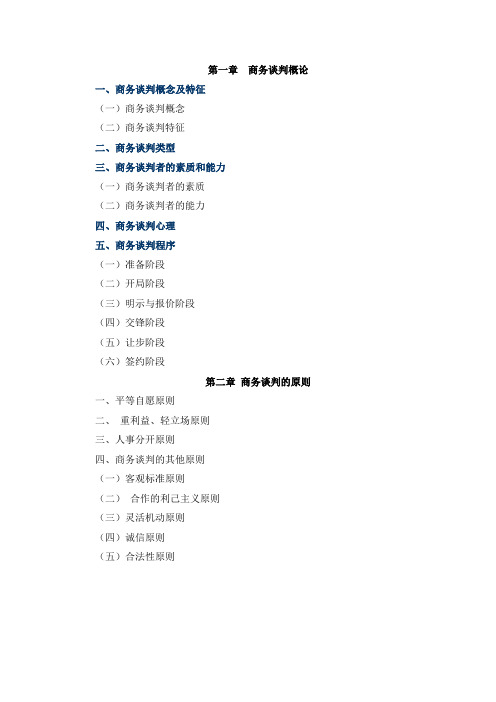
一、商务谈判概念及特征(一)商务谈判概念(二)商务谈判特征二、商务谈判类型三、商务谈判者的素质和能力(一)商务谈判者的素质(二)商务谈判者的能力四、商务谈判心理五、商务谈判程序(一)准备阶段(二)开局阶段(三)明示与报价阶段(四)交锋阶段(五)让步阶段(六)签约阶段第二章商务谈判的原则一、平等自愿原则二、重利益、轻立场原则三、人事分开原则四、商务谈判的其他原则(一)客观标准原则(二)合作的利己主义原则(三)灵活机动原则(四)诚信原则(五)合法性原则一、谈判背景调查二、收集、整理信息与确定谈判目标(一)收集、整理信息(二)确定谈判目标三、谈判的议程(一)时间安排(二)确定谈判议题(三)通则议程与细则议程(四)商务谈判场所的选择(五)商务谈判场景的选择与布置(六)谈判班子组成四、商务谈判模拟(一)模拟谈判的概念(二)模拟谈判的作用(三)模拟谈判的任务(四)模拟谈判的方法第四章商务谈判开局一、商务谈判的开局方式二、谈判开局气氛的营造第二节商务谈判的开局策略(一)一致式开局策略(二)保留式开局策略(三)坦诚式开局策略(四)进攻式开局策略(五)挑剔式开局策略二、策划开局策略应考虑的因素(一)考虑谈判双方之间的关系(二)考虑双方的实力(三)考虑谈判策略的需要三、引起谈判对手注意与兴趣的技巧第五章商务谈判磋商一、报价(一)报价的原则(二)报价的形式(三)报价的顺序(四)报价策略二、讨价还价(三)讨价还价的策略(1)故布疑阵(2)投石问路(3)抛砖引玉(4)吹毛求疵(5)价格诱惑(6)目标分解案例二(7)润滑策略(8)请君入瓮2.讨价还价阶段中期的策略运用(1)步步为营(2)疲劳轰炸(3)以林遮木(4)软硬兼施(5)车轮战术(6)休会策略3.讨价还价阶段后期的策略运用1)最后通牒2)场外交易3)私下接触4)权利有限5)坐收渔利让步1.迫使对手让步的方式有哪些?2.阻止对手进攻的方式有哪些?第六章商务谈判僵局的处理一、僵局的含义及对谈判的影响(一)僵局的含义及类型1.僵局含义2.僵局的类型3.僵局对谈判的影响二、商务谈判僵局产生的原因三、商务谈判僵局的处理原则(一)正确认识谈判的僵局(二)冷静地理性思考(三)协调好双方的利益(四)避免争吵(五)其他原则四、商务谈判僵局的利用和制造五、打破谈判僵局的策略第七章商务谈判的结束一、谈判结束的契机第八章商务谈判的战术及应用一、情感渗透法二、巧打时间差法三、其他方法(一)投其所好法(二)“升格”法(三)激将法(四)最后通牒法(五)吹毛求疵法(六)竞争法(七)缓兵之计法(八)金蝉脱壳法(九)放线钓鱼法(十)化整为零法(十一)捆绑利益法(十二)追根究底法(十三)针锋相对法第九章商务谈判的语言艺术一、谈判语言概述二、谈判有声语言运用的技巧(一)倾听的技巧(二)问的技巧三、谈判无声语言运用的技巧第十章商务谈判礼仪一、商务谈判礼仪二、商务谈判礼节三、一些国家的习俗与禁忌。
《商务谈判》复习大纲1507
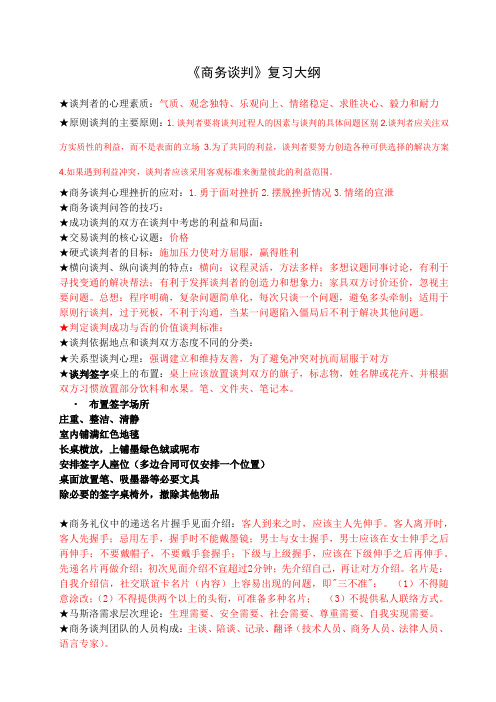
《商务谈判》复习大纲★谈判者的心理素质:气质、观念独特、乐观向上、情绪稳定、求胜决心、毅力和耐力★原则谈判的主要原则:1.谈判者要将谈判过程人的因素与谈判的具体问题区别2.谈判者应关注双方实质性的利益,而不是表面的立场 3.为了共同的利益,谈判者要努力创造各种可供选择的解决方案4.如果遇到利益冲突,谈判者应该采用客观标准来衡量彼此的利益范围。
★商务谈判心理挫折的应对:1.勇于面对挫折2.摆脱挫折情况3.情绪的宣泄★商务谈判问答的技巧:★成功谈判的双方在谈判中考虑的利益和局面:★交易谈判的核心议题:价格★硬式谈判者的目标:施加压力使对方屈服,赢得胜利★横向谈判、纵向谈判的特点:横向:议程灵活,方法多样;多想议题同事讨论,有利于寻找变通的解决帮法;有利于发挥谈判者的创造力和想象力;家具双方讨价还价,忽视主要问题。
总想:程序明确,复杂问题简单化,每次只谈一个问题,避免多头牵制;适用于原则行谈判,过于死板,不利于沟通,当某一问题陷入僵局后不利于解决其他问题。
★判定谈判成功与否的价值谈判标准:★谈判依据地点和谈判双方态度不同的分类:★关系型谈判心理:强调建立和维持友善,为了避免冲突对抗而屈服于对方★谈判签字桌上的布置:桌上应该放置谈判双方的旗子,标志物,姓名牌或花卉、并根据双方习惯放置部分饮料和水果。
笔、文件夹、笔记本。
•布置签字场所庄重、整洁、清静室内铺满红色地毯长桌横放,上铺墨绿色绒或呢布安排签字人座位(多边合同可仅安排一个位置)桌面放置笔、吸墨器等必要文具除必要的签字桌椅外,撤除其他物品★商务礼仪中的递送名片握手见面介绍:客人到来之时,应该主人先伸手。
客人离开时,客人先握手;忌用左手,握手时不能戴墨镜;男士与女士握手,男士应该在女士伸手之后再伸手;不要戴帽子,不要戴手套握手;下级与上级握手,应该在下级伸手之后再伸手。
先递名片再做介绍;初次见面介绍不宜超过2分钟;先介绍自己,再让对方介绍。
名片是:自我介绍信,社交联谊卡名片(内容)上容易出现的问题,即"三不准":(1)不得随意涂改;(2)不得提供两个以上的头衔,可准备多种名片;(3)不提供私人联络方式。
商务谈判复习提纲
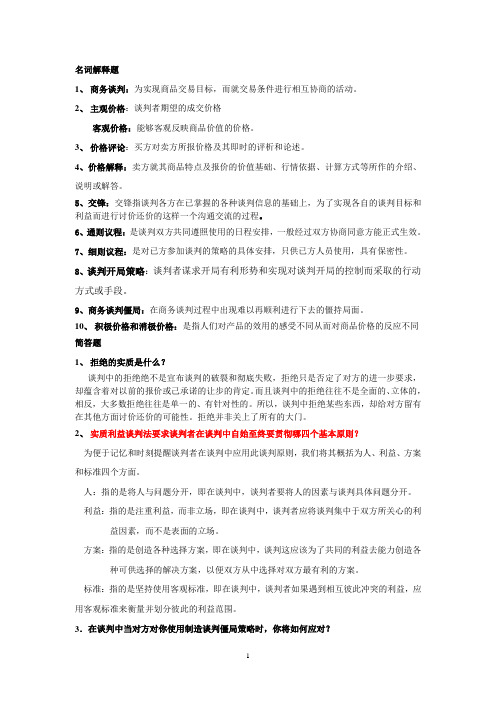
名词解释题1、商务谈判:为实现商品交易目标,而就交易条件进行相互协商的活动。
2、主观价格:谈判者期望的成交价格客观价格:能够客观反映商品价值的价格。
3、价格评论:买方对卖方所报价格及其即时的评析和论述。
4、价格解释:卖方就其商品特点及报价的价值基础、行情依据、计算方式等所作的介绍、说明或解答。
5、交锋:交锋指谈判各方在已掌握的各种谈判信息的基础上,为了实现各自的谈判目标和利益而进行讨价还价的这样一个沟通交流的过程。
6、通则议程:是谈判双方共同遵照使用的日程安排,一般经过双方协商同意方能正式生效。
7、细则议程:是对已方参加谈判的策略的具体安排,只供已方人员使用,具有保密性。
8、谈判开局策略:谈判者谋求开局有利形势和实现对谈判开局的控制而采取的行动方式或手段。
9、商务谈判僵局:在商务谈判过程中出现难以再顺利进行下去的僵持局面。
10、积极价格和消极价格:是指人们对产品的效用的感受不同从而对商品价格的反应不同简答题1、拒绝的实质是什么?谈判中的拒绝绝不是宣布谈判的破裂和彻底失败,拒绝只是否定了对方的进一步要求,却蕴含着对以前的报价或己承诺的让步的肯定。
而且谈判中的拒绝往往不是全面的、立体的,相反,大多数拒绝往往是单一的、有针对性的。
所以,谈判中拒绝某些东西,却给对方留有在其他方面讨价还价的可能性。
拒绝并非关上了所有的大门。
2、实质利益谈判法要求谈判者在谈判中自始至终要贯彻哪四个基本原则?为便于记忆和时刻提醒谈判者在谈判中应用此谈判原则,我们将其概括为人、利益、方案和标准四个方面。
人:指的是将人与问题分开,即在谈判中,谈判者要将人的因素与谈判具体问题分开。
利益:指的是注重利益,而非立场,即在谈判中,谈判者应将谈判集中于双方所关心的利益因素,而不是表面的立场。
方案:指的是创造各种选择方案,即在谈判中,谈判这应该为了共同的利益去能力创造各种可供选择的解决方案,以便双方从中选择对双方最有利的方案。
标准:指的是坚持使用客观标准,即在谈判中,谈判者如果遇到相互彼此冲突的利益,应用客观标准来衡量并划分彼此的利益范围。
《商务谈判》复习大纲

《商务谈判》复习大纲一、单选题1、商务谈判中所谓合理价格,是指能(D)的价格。
A、价廉物美B、货真价实C、市场通行D、体现双方共同利益2、(C)是双方下决心按磋商达成的最终交易条件成交的阶段。
A、报价阶段B、开局阶段C、成交阶段D、磋商阶段3、(A)是谈判双方共同遵照使用的日程安排,一般要经过双方协商同意后方能正式生效。
A、通则议程B、细则议程C、会议安排D、谈判地点安排4、谈判是追求(C)的过程。
A、自身利益要求B、双方利益要求C、双方不断调整自身需要,最终达成一致D、双方为维护自身利益而进行的智力较量5、下列哪一项是商务谈判的基本原则?(B)A、唯利是图B、平等互利C、全盘让步D、坚守立场6、按谈判中双方所采取的的态度,可以将谈判分为硬式谈判、原则式谈判和(A)。
A、软式谈判B、集体谈判C、横向谈判D、投资谈判7、(B)可以广泛收集相关信息,利于实现调查者的主导意向,易于整理分析。
A、访谈法B、问卷法C、观察法D、实验法8、对于主要的议题或争执较大的焦点问题,最好安排在总谈判时间的(D)时提出来。
A、1/4B、1/7C、6/7D、3/59、(C)是谈判求胜的心理基础。
A、诚心B、耐心C、信心D、拖延10、在谈判时,作为主谈人首先应该做的第一件事是(A)。
A、介绍对方在场人员B、公司领导介绍C、了解对方人员D、递名片11.谈判中讨价还价集中体现在什么行为中(D)。
A.问B.叙C.答D.辩12.同外商初次交往时,喜欢先进行个人直接面谈,而不喜欢通过书信结交的是(D)。
A.美国人B.英国人C.法国人D.日本人13.谈判中的关键阶段是(C)。
A.报价阶段B.开局阶段C.磋商阶段D.成交阶段14.进行较为陌生且缺少经验的谈判,宜采取(C)。
A.坚定让步型B.递减让步型C.等额让步型D.递增让步型15.在一方报完价之后,另一方比较策略的做法是(C)。
A.马上还价B.置之不理、转移话题C.请对方作出价格解释D.亮出已方的价格条件16、卖方有100元的让步权限,要求四次让完,合适的让步方式是(C)。
《商务谈判》复习提纲
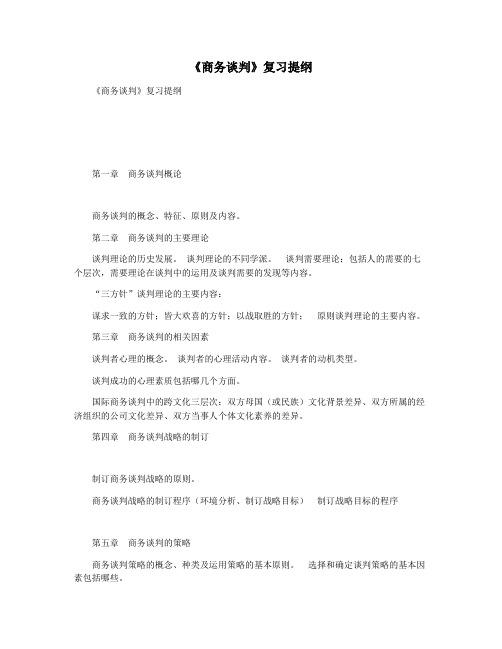
《商务谈判》复习提纲《商务谈判》复习提纲第一章商务谈判概论商务谈判的概念、特征、原则及内容。
第二章商务谈判的主要理论谈判理论的历史发展。
谈判理论的不同学派。
谈判需要理论:包括人的需要的七个层次,需要理论在谈判中的运用及谈判需要的发现等内容。
“三方针”谈判理论的主要内容:谋求一致的方针;皆大欢喜的方针;以战取胜的方针;原则谈判理论的主要内容。
第三章商务谈判的相关因素谈判者心理的概念。
谈判者的心理活动内容。
谈判者的动机类型。
谈判成功的心理素质包括哪几个方面。
国际商务谈判中的跨文化三层次:双方母国(或民族)文化背景差异、双方所属的经济组织的公司文化差异、双方当事人个体文化素养的差异。
第四章商务谈判战略的制订制订商务谈判战略的原则。
商务谈判战略的制订程序(环境分析、制订战略目标)制订战略目标的程序第五章商务谈判的策略商务谈判策略的概念、种类及运用策略的基本原则。
选择和确定谈判策略的基本因素包括哪些。
制定商务谈判策略的步骤。
按谈判地位制定策略:按谈判主动地位制定的策略;按被动地位而采取的谈判策略;处于平等地位的谈判策略。
按对方主谈人的性格制定策略:针对强硬性格主谈人的谈判策略;针对主谈人懦弱性格的策略;针对主谈人理想性格的策略;针对主谈人无主见性格的策略;针对主谈人刚愎自用性格的策略:离间策略、激将法策略。
针对不同谈判作风制定的策略:针对直率、实际型作风的策略;针对“阴谋型”谈判作风的策略;针对缺乏灵活性型谈判作风的策略;针对自负型谈判作风的策略;针对“虚荣型”作风的策略;针对散漫型作风的策略;针对装扮可怜相谈判作风的策略。
第六章商务谈判的语言艺术商务谈判的语言特征(包括内在和外在特征)。
商务谈判的倾听技巧。
如何做到有效的倾听。
商务谈判的提问技巧:包括提问的时机及要决。
运用商务谈判说服技巧的基本原则和具体方式。
商务谈判的非语言沟通的作用和表达形式。
第七章商务谈判前的准备商务谈判信息准备的含义及谈判信息的种类。
商务谈判复习提纲
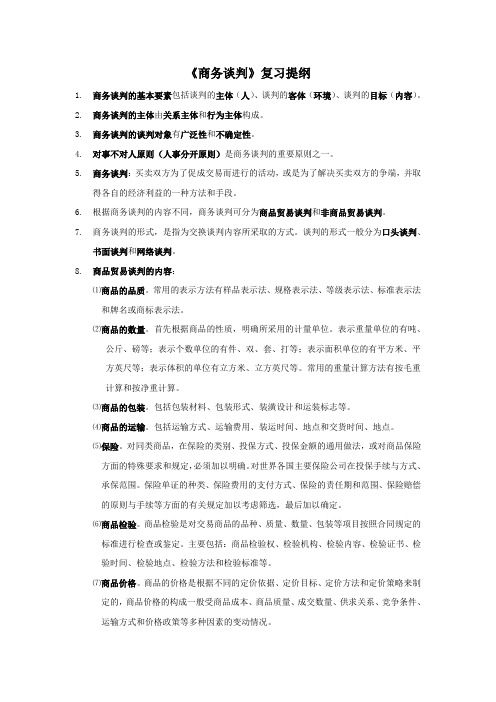
《商务谈判》复习提纲1.商务谈判的基本要素包括谈判的主体(人)、谈判的客体(环境)、谈判的目标(内容)。
2.商务谈判的主体由关系主体和行为主体构成。
3.商务谈判的谈判对象有广泛性和不确定性。
4.对事不对人原则(人事分开原则)是商务谈判的重要原则之一。
5.商务谈判:买卖双方为了促成交易而进行的活动,或是为了解决买卖双方的争端,并取得各自的经济利益的一种方法和手段。
6.根据商务谈判的内容不同,商务谈判可分为商品贸易谈判和非商品贸易谈判。
7.商务谈判的形式,是指为交换谈判内容所采取的方式。
谈判的形式一般分为口头谈判、书面谈判和网络谈判。
8.商品贸易谈判的内容:⑴商品的品质。
常用的表示方法有样品表示法、规格表示法、等级表示法、标准表示法和牌名或商标表示法。
⑵商品的数量。
首先根据商品的性质,明确所采用的计量单位。
表示重量单位的有吨、公斤、磅等;表示个数单位的有件、双、套、打等;表示面积单位的有平方米、平方英尺等;表示体积的单位有立方米、立方英尺等。
常用的重量计算方法有按毛重计算和按净重计算。
⑶商品的包装。
包括包装材料、包装形式、装潢设计和运装标志等。
⑷商品的运输。
包括运输方式、运输费用、装运时间、地点和交货时间、地点。
⑸保险。
对同类商品,在保险的类别、投保方式、投保金额的通用做法,或对商品保险方面的特殊要求和规定,必须加以明确。
对世界各国主要保险公司在投保手续与方式、承保范围。
保险单证的种类、保险费用的支付方式、保险的责任期和范围、保险赔偿的原则与手续等方面的有关规定加以考虑筛选,最后加以确定。
⑹商品检验。
商品检验是对交易商品的品种、质量、数量、包装等项目按照合同规定的标准进行检查或鉴定。
主要包括:商品检验权、检验机构、检验内容、检验证书、检验时间、检验地点、检验方法和检验标准等。
⑺商品价格。
商品的价格是根据不同的定价依据、定价目标、定价方法和定价策略来制定的,商品价格的构成一般受商品成本、商品质量、成交数量、供求关系、竞争条件、运输方式和价格政策等多种因素的变动情况。
2024年商务谈判提纲总结范本(二篇)

2024年商务谈判提纲总结范本第一部分:引言1. 引起对谈判话题的兴趣- 提及背景信息和共同利益- 引用相关数据或统计数据2. 陈述谈判目标- 简要概述谈判目标- 表明实现目标的重要性第二部分:情况分析1. 分析双方利益、需求和约束条件- 强调双方的共同利益- 识别双方的需求和限制2. 简要评估对手的立场和意图- 研究对手的背景和利益- 推测对手可能采取的谈判策略第三部分:谈判策略1. 制定主要谈判策略- 强调合作而不是竞争的原则- 设定最佳解决方案的目标2. 讨论可选的谈判策略- 引用相关案例和经验教训- 分析每种策略的风险和收益3. 提出应对对手策略的方法- 强调灵活性和适应性- 讨论如何回应可能的对手策略第四部分:谈判计划1. 制定谈判议程和时间表- 分配充足的时间给每个议题- 安排合适的休息时间2. 选择合适的谈判地点和设施- 考虑谈判所需的设备和资源- 选择一个中立和方便的地点3. 分派谈判团队的角色和职责- 确定团队成员的角色和职责- 指定一位主要谈判代表第五部分:沟通和语言技巧1. 有效的沟通技巧- 倾听和理解对方观点- 清晰表达自己的观点和需求2. 控制谈判过程中的情绪- 管理自己的情绪和表现- 采取冷静和专业的态度3. 使用合适的语言技巧- 避免冲突和攻击性语言- 使用积极和建设性的措辞第六部分:协议和协商1. 寻求共赢的解决方案- 强调合作和互惠原则- 探讨双方可以实现的妥协方案2. 协商技巧- 讨论创造性解决方案的方法- 提出合理的交换条件3. 概述达成一致的步骤和程序- 确定达成协议的步骤和时间表- 预测可能的障碍和解决方法第七部分:结束和跟进1. 对谈判结果给予总结和评估- 讨论达成协议的效果和影响- 评估双方的谈判表现2. 确定后续行动和跟进措施- 制定协议实施的计划- 规划后续沟通和合作机会第八部分:结语1. 强调谈判的重要性和价值- 引用成功的商务谈判案例- 概述谈判的积极影响2. 鼓励谈判参与者的合作和互信- 强调团队合作和信任的重要性- 鼓励积极参与和互动以上是商务谈判提纲的总结,总字数为____字。
中央财经大学《国际商务谈判》复习提纲 复习重点
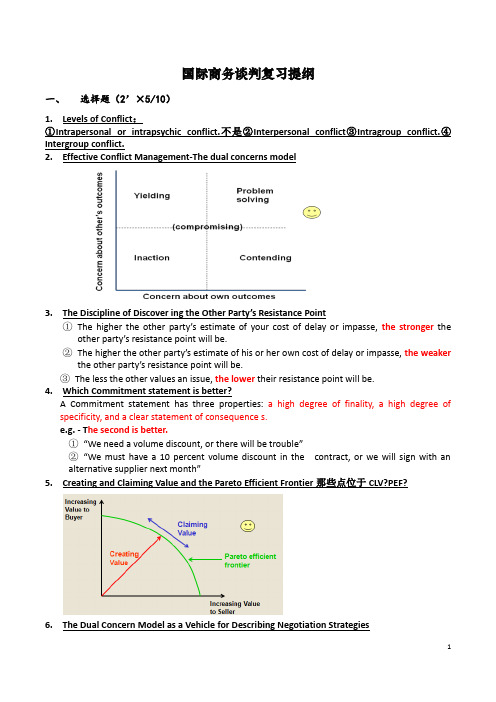
国际商务谈判复习提纲一、选择题(2’×5/10)1.Levels of Conflict:①Intrapersonal or intrapsychic conflict.不是②Interpersonal conflict③Intragroup conflict.④Intergroup conflict.2.Effective Conflict Management-The dual concerns model3.The Discipline of Discover ing the Other Party’s Resistance Point①The higher the other party’s estimate of your cost of delay or impasse,the stronger theother party’s resistance point will be.②The higher the other party’s estimate of his or her own cost of delay or impasse,the weakerthe other pa rty’s resistance point will be.③The less the other values an issue,the lower their resistance point will be.4.Which Commitment statement is better?A Commitment statement has three properties:a high degree of finality, a high degree ofspecificity, and a clear statement of consequence s.e.g. - T he second is better.①“We need a volume discount, or there will be trouble”②“We must have a 10 percent volume discount in the contract, or we will sign with analternative supplier next month”5.Creating and Claiming Value and the Pareto Efficient Frontier那些点位于CLV?PEF?6.The Dual Concern Model as a Vehicle for Describing Negotiation Strategies7.Manageable and unmanageable questionsManageable questions cause attention or prepare the other person’s thinking for future questions (“May I ask you a question?”), get information (“How much will this cost?”) and generate thoughts (“Do you have any suggestion for improving this?”)Unmanageable questions give information (“Didn’t you know that we couldn’t afford this”), and bring the discussion to a false conclusion (“Don’t you think we have talked about this enough?”)·Unmanageable questions are likely to produce defensiveness and anger in the other party.·Unmanageable questions are likely to make the other party feel uncomfortable and less willing to provide information in the future8.Categories of Third - Party Interve ntionautocracy mediation arbitration negotiation二、填空题(1’×7)1.Phases of Negotiation2.Types of third-party interventionThis is followed by an examination of the types of third-party intervention, with special attention paid to three formal third-party roles: arbitration, mediation, and process consultation.三、简答题(8’×5)1.Explain the differences between Negotiation and Bargain?Be careful about how we use bargaining and negotiation.①zero-sum and non-zero-sum②relationship between parties-cooperation and opposition③Bargain belongs to Negotiation2.Characteristics of a Negotiation Situation①There are two or more parties.②There is a conflict of needs and desires between two or more parties.③The parties negotiate by choice.④When we negotiate we expect a “give and take ” process.⑤The parties prefer to negotiate and search for agreement.⑥Successful negotiation involves the management of tangibles & also the resolution of intangibles.First, the dilemma of honesty, concerns how much of the truth to tell?Second, the dilemma of trust, how much should the negotiators believe what the other party tells them?4.What are the kinds of Levels of Conflict? Does each one apply to the Negotiation?①Intrapersonal or intrapsychic conflict.Want an ice cream which is very fattingAnger with a boss with afraid to express②Interpersonal conflict.Between workers, spouses, siblings, roommates③Intragroup conflict.Within families, classes, living units, and tribes④Intergroup conflict.Between organizations, ethnic groups, warring nations, or feuding families.NO, the first level of conflict- Intrapersonal conflict - isn’t the object negotiation concerns.5.The Distributive Bargaining Situation•Target point-•Resistance point-•Starting point-6.What is the BATNA?BATNA, Best Alternative To a Negotiated Agreement,•BATNAs --- Best Alternative to a Negotiated Agreement.The availability of a BATNA offers a negotiator significant power because she now has a choice between accepting the other party’s proposal or the alternative deal.Negotiators can use the BATNA as leverage to strike a better agreement in the current discussion.7.The advantages and disadvantages of exaggerated opening offer.夸张的开场报价Advantages:It appears that first offers can anchor a negotiation. An exaggerated opening offer may be advantageous.Exaggerated opening offer brings much bigger subsequent concessions.Disadvantageous:①it may be summarily rejected by the other party;②it communicates an attitude of toughness that maybe harmful to long-term relationships.8.Which Pattern of Concession Making is better? Why?谁的妥协过程更好?金额、次数First concession conveys a message, frequently a symbolic one to the other party that how you will proceed.Firmness may actually shorten negotiations, there is also the very real possibility, however, it will be reciprocated by the other.There are good reasons for adopting a flexible position.Parties feel better about a settlement when the negotiation involved a progression of concession.Size of concessionConcession number⏹Good Cop / Bad CopAlthough the good cop/bad cop tactic can be somewhat transparent, it often lead to concessions and negotiated agreements..⏹Lowball/HighballStart with a ridiculously low (or high) opening offer that they know they will never achieve.The union’s first offer was to request a 45 percent salary increase over three years with in neighboring universities had been 3 to 4 percent.Risk: the other party will think negotiating is a waste of time and will stop negotiating.⏹BogeyNegotiators pretend that an issue of little or no importance to them is quite important. Later in the negotiation, this issue can then be traded for major concessions on issues that are actuallyimportant to them.⏹The NibbleNegotiators ask for a proportionally small concession on an item that hasn’t been discussed previously in order to close the deal.Two ways to combat: (1) What else do you want? (2) Have your own nibbles prepared to offer in exchange.⏹The ChickenTwo people driving cars at each other or toward a cliff until one person swerves to avoid disaster.The person who serves is labeled a chicken, and the other person is treated like a hero.The weakness is that it turns negotiation into a serious game in which one or both parties find it difficult to distinguish reality from postured negotiation positions.⏹IntimidationIt attempts to force the other party to agree by means of an emotional ploy, usually anger or fear.Farmer workers ask for wages from employers.⏹Aggressive Behavior“You can do better than that”Let’s not waste any time. What is the most that you will pay?An excellent response is to halt the negotiations in order to discuss the negotiation process itself.⏹Snow JobIt occurs when negotiators overwhelm the other party with so much information that he or she has trouble determining which facts are real or important, and which are include merely asdistractions.Government may use it when releasing information publicly.Use of highly technical language to hide a simple answer to a question asked by a non-export.10.Key Steps in the Integrative Negotiation (major steps in the integrative negotiation process).①Identify and Define the Problem.②Understand the Problem Fully — Identify Interests and Needs.③Generate Alternative Solutions.④Evaluate and Select Alternatives①②③are creating value and the④is claiming value.11.What are Interests? & Difference between Interests and Position.Interests are the underlying concerns, needs, desires, or fears that motivate a negotiator to take particular position.Positions are what a negotiator wants.A target point of $135,000 for a condo would be a position which is what the negotiator hopes topay.Interests are why she wants them.The interest would be “to pay a fair market price, and one I can afford, for that two bedroom condo”Asking “why” questions usually bring critical values, needs, or principles that we want to achieve in the negotiation to the surface12.Generate Alternative Solutions⏹Expand the Pie•Many negotiations began with a shortage of resource, and it is not possible for both sides to satisfy their interests or obtain their objectives under the current condition.•A simple solution is to add resources.•Both sides can achieve their objectives.•This approach assumes that simply enlarging the resources will solve the problem.⏹Logroll•Successful logrolling requires the parties to find more than one issue in conflict and to have differentpriorities for those issues.•The parties then agree to trade off among these issues so that one party achieves a highly preferred outcome on the first issue and the other person achieves a highly preferred outcome on the second issues.•Example:Two partner of a company.Alice prefers downtown while Emma prefers suburb location.Alice prefers large office while Emma doesn’t care much about it.The business could locate in the suburbs and give Alice the bigger office.⏹Use Nonspecific Compensation•Allow one person to obtain his objectives and pay off the other person.•The pay off may be unrelated to the substantive negotiation.•The party who receives it views it as adequate for agreeing to the other party’s preference.•The person doing the compensating needs to know what is valuable to the other person and how much compensation is needed to make her feel satisfied.•This discovery process can turn into a distributive bargaining situation.⏹Cut the cost for Compliance•One party achieves her objectives and the other’s costs are minimized if she agrees to go along.•Example: The business could lease in the suburbs and provide Alice with a travel subsidy and a new company car and reserved parking space.Unlike nonspecific compensation, where the compensated party simply receives something for agreeing, cost cutting is designed to minimize the other party’s costs for agreeing to a solution⏹Find a Bridge Solution•The parties are able to invent new options that meet all their respective needs.•Successful bridging requires a fundamental reformulation of the problem.•Example: The firm could expand the number of partners and locate in the downtown.•Bridging solutions do not always remedy all concerns, but both have worked to invent a solution that meets their most important needs.⏹Brainstorming•The success of brainstorming depends on the amount of intellectual stimulation that occurs as different ideas are generated. The following rules should be observed:Avoiding judging or revaluating solutions.Be exhaustive in the brainstorming process.Ask outsiders.⏹Surveys•The brainstorming does not solicit the ideas of those who are not present at the negotiation.•The surveys are to distribute a written questionnaire to a large number of people.•The parties c annot benefit from seeing and hearing other people’s ideas, a key advantage of brainstorming.⏹Electronic Brainstorming•An innovative method for gathering ideas is to engage a professional facilitator and use electronic brainstorming.•Electronic brainstorming may be especially useful for integrative negotiations that involve multiple parties or during preparation for integrative negotiations when there are disparate views within one’s team.13.The difference between Strategy and Tactics, then give examples.战略和战术的区别举例①Tactics are short-term, adaptive moves designed to enact or pursue broad (or higher-level) strategies.②Strategies, which in turn provide stability, continuity, and direction for tactical behaviors.Examples: Strategy --- To push for a settlemen t close to the seller’s resistance point.Tactics --- Hardball tactics of Good Cop / Bad cop, the Chicken, Snow Job, etc.14.Define Interests position与interests区别?Define the underlying interests and needsPositions are what a negotiator wants.· A target point of $135,000 for a condo would be a position which is what the negotiator hopes to pay.Interests are why she wants them.·The interest would be “to pay a fair market price, and one I can afford, for that two bedroom condo”Asking “why” questions usually b ring critical values, needs, or principles that we want to achieve in the negotiation to the surface15.Cognitive Biases in NegotiationMythical Fixed-Pie Belief•Many negotiators assume that all negotiations involve a fixed pie.•The tendency to see negotiation in fixed-pie terms varies depending on how people view the nature ofa given conflict situation.•Simulated negotiation between prosecutors and defense lawyers over jail sentences.View the goals in terms of personal interestsTo focus on values (fair and just)Fixed-pie belief in the former viewAnchoring and Adjustment•The choice of an anchor might well be based on faulty or incomplete information and thus be misleading in and of itself.•However, once the anchor is defined, parties tend to treat it as a real, valid benchmark by which to adjust other judgments.•Through preparation, along with the use of reality check, can help prevent errors .The Winner’s Curse•The winner’s curse refers to the tendency of negotiators, particularly in an auction setting, to settle quickly on an item and then subsequently feel discount about a negotiation win that comes too easily.•The negotiator may suspect that the other party knows too much or has insight into an unseen advantage.•The easier it is to imagine a better alternative to an agreement, the less satisfied the negotiator will be. The Law of Small Numbers•In decision theory, the law of small numbers refers to the tendency of people to draw conclusions from small sample sizes.•In negotiation, the law of small numbers applies to the way negotiators learn and extrapolate from their own experience.•If that experience is limited in time and in scope, the tendency is to extrapolate prior experience onto future negotiations.•The fallacy result in a tendency to believe that a small sequence of events is representative, while ignoring base rate data from a larger universe of events.Self-Serving Biases•People often explain another person’s behavior by making attributions, either to the person or to the situation.•In “explaining” another person’s behavior, the tendency is to overestimate the causal role of personal or internal factors and underestimate the causal role of situational or external factors.•People tend to attribute their own behavior to situational factors but at tribute others’ behavior to personal factors.16.How People use of nonverbal communication to Communicate in Negotiation?Give examples.①Make eye contact - e.g. 倾听对方谈话时,几乎不看对方,在某些方面可能有试图掩饰的情况②Adjust body position - e.g. 紧握拳头,表示向对方挑战,或是自我紧张情绪的外露③Nonverbally encourage or discourage what the other says - e.g. 用手指或手中的笔敲打桌面,或在纸上乱涂乱画,表示对对方的话题不感兴趣、不同意或不耐烦17.Illustrate three channels Communication occurs through and analyse each channel.请列举3种渠道?举一个例子适合这个渠道?①Face to face on a “negotiation table”希望观察对方面部表情和及时反馈②Over the telephone距离遥远③In writing对弱势一方相对更公平④Electronic channels such as email, instant message and teleconferencing systems•Channel variations have potentially important effects on negotiation processes and outcomes Over the telephone preserves the tone of voice, whiling it contains no facial expressions or physical gesturesWriting is formal and more prepared but has no immediate reaction•More easily develop personal rapport in face-to-face communication compared to other channels.•Face-to-face negotiators are more inclined to disclose information truthfully, increasing their ability to attain mutual gain.•E-mail negotiators reach agreements that are more equal (a balanced diversion of resources) than face-to-face negotiators•E-mail may indeed help less interpersonally skilled parties improve their performance, especially when the alternative is negotiating spontaneously (face-to-face or by phone) with a more accomplished other party.18.The types of listening.三种分别是什么①Passive listening - Receiving the message while providing no feedback to the sender②Acknowledgment - Receivers occasionally nod their heads, maintain eye-contact, or interject responseslike ‘I see,’ ‘mm-hmm’, ‘Interesting’, ‘Really’, ‘sure’, ‘go on’.③Active listening - Receivers restate or paraphrase the sender’s message in their own language.Among three types, Active listening is the best, which has generally been recommended for counseling communications.19.Difference between “Power over” and “Power with”.There are two perspectives on power-①Power used to dominate and control the other.②Power used to work together with the other.“Power over”•The power is fundamentally dominating and coercive in nature.•This use of power implies powerlessness and dependence on the receiving end.“Power with”•The power holder jointly develops and shares power with the other.•The receiver experiences this power as empowered and independent.20.Explain 3 methods of Dealing with Others Who have More Power. 举例①Never do an all-or-nothing deal.②Make the other Party smaller.③Make yourself bigger.④Build momentum through doing deals in sequence.⑤Use the power of competition to leverage power.⑥Constraint yourself⑦Good information is always a source of power.⑧Do what you can to manage the process.21.Difference between Two Routes to Influence中心路线与外围路线差别•Two general path by which people are persuaded•Central Route (Is the Influence target motivated and able to carefully process the message?-YES) It occurs consciously and involves integrating the message into t he individual’s previously existing cognitive structures, thoughts, intellectual frameworks, etc.It occurs when motivation and ability to scrutinize issue-relevant arguments are relatively high.•Peripheral Route (Is the Influence target motivated and able to carefully process the message?-NO) It is characterized by subtle cues and context, with less cognitive processing of the message.Persuasion via the peripheral route is thought to occur automatically, out of conscious awareness, leading to “attitude change without argument scrutiny.”Persuasion occurring via this route is likely to last a shorter time than persuasion occurring via the central route.22.Definition of One-and Two-Sided Messages. And which one do you prefer?•When negotiators try to persuade the other party it is because they believe that the other party holds an opinion different from theirs.•One-sided approach: Many people deal with this problem by ignoring argument and opinions that might support the other party’s position.•Two-sided approach: An alternative approach to ignoring the competition is to mention and describe the opposing point of view, and then show how and why it is less desirable than the presenter’s point of view.•In general, two-sided messages are considered to be more effective than one-sided message23.What do you think of Reciprocity在外围路线如何理解互利互惠性?•Although one may think that the norm of reciprocity should apply only to favors of the same size, this does not appear to be the case•Many sales pitches rely on giving the consumer a small gift early in an exchange and then asking for a large concession from the consumer later.•Too often negotiators begin by holding every advantage close to their chest and giving things away grudgingly, believing that this is the best way to succeed.放弃一些比较容易达到双赢的结局!•Flexibility and adaptability are necessary.24.What is “Bait-and-switch sales”?什么是?引诱、钓鱼•Once people have decided something, they can be remarkably persistent in their beliefs•This process has been labeled commitment to a position•Bait-and-switch sales•Commitment strategies are very powerful devices for making people comply.•It is incremental that commitment can work in a negotiation.•Agreement to innocuous statements early in the negotiation may be used as a foundation for further and further concession25.How to Resist the other’s influence如何拒绝别人对的影响?Three major things that listeners can do to resist the other’s influence efforts①Have good alternatives to a negotiated agreement②Make a public commitment③Inoculate yourself against the other’s persuasive message26.What is the Nature of Impasses僵局①Impasses is not necessarily bad or destructive (although it can be ).②Impasses does not have to be permanent.③Impasses can be tactical or genuine.④Impasses perception can differ from reality.27.Ury’s Breakthrough Approach•Step1: Don’t react --- Go to the balcony•Step2: Disarm them --- Step to their side•Step3: Change the game --- Don’t reject, Reframe•Step4: Make it easy to say yes --- Build them a golden bridge•Step5: Make it hard to say no --- Bring them to their sense, not their knees.28.How to manage difficult conversations?•Clarity --- It means to use language that is as precise as possible when managing a difficult conversation •Tone--- It is the nonverbal aspect of the conversation and it includes “intonation, facial expressions, conscious an d unconscious body language”.•Temperate phrasing --- It involves choosing language carefully to deliver a message that will not provoke the other side.四、问答题(10’×3)1.What is perception distortion? What are 4 major perceptual errors and give examples?Answer:•In any given negotiation, the perceiver’s own needs, desires, motivations, and personal experiences may influence her perception about the other party.•This is cause for concern when it leads to biases and errors in perception and subsequent communication.•Four major perceptual errors:Stereotyping•Stereotyping is a very common distortion of the perceptual process•It occurs when one individual assigns attributions to another solely on the basis of the other’s membership in a particular social or demographic category.•People assign an individual to a group based on one piece of perceptual information, then they assign a broad range of other characteristics of the group to this individual.•There may be no factual basis for the conclusion.•Once formed, stereotypes are often highly resistant to change.•Conflicts involving values, ideologies, and direct competition for resources among groups increase the likelihood that stereotyping will occur.Halo effects•Halo Effects occurs when people generalize about a variety of attributes based on the knowledge of one attribute of an individual.•Halo effects may be positive or negative•Halo effects are most likely to occur in perceptionWhen there is very little experience with a person along some dimensionWhen the person is well knownWhen the qualities have strong implicationsSelective perception•Selective Perception occurs when the perceiver singles out certain information that supports or reinforces a prior belief and filters out information that does not confirm that belief.•After forming quick judgments about individuals on the basis of limited information by perpetuating stereotypes or halo effects, people may then filter out further evidence that might disconfirm thejudgment.•The negotiator’s own biases are likely to affect how the other party’s behavior is perceived and interpreted.Projection•Projection occurs when people assign to others the characteristics or feelings that they possess themselves.•Negotiators may assume that the other party would respond in the same manner they would if position were reversed.•People respond differently to similar situations, however, and projecting one’s own feeling and beliefs onto the other negotiator may be incorrect.•Stereotyping and halo effects are examples of perceptual distortion by generalizationSmall amounts of perceptual information are used to drew large conclusions about individuals.•Selective perception and projection are, in contrast, forms of distortion that involve anticipating certain attributes and qualities in another person.The perceiver filters and distorts information to arrive at a consistent view.•Perceptual distortion can influence many aspects of the negotiation process and can be quite persistent once they are formed.•This problem may be most acute betweenGroups that have long-standing hostile relationshipsUnions and management that have been plagued by bitter strikesEthnic groups with ongoing disagreementsMarital partners in divorce proceedings2.How People Acquire Power? Demonstrate those five types and give examples.• A broader perspective on power as relates to negotiation and aggregate the major sources of power into five different groups:①Informational sources of power•It is derived from the negotiator’s ability to assemble and organize fa cts and data to support his or her position, arguments, or desired outcomes.•The exchange of information is also at the heart of concession-making process.•The exchange of information serves as a rationale for both sides to modify their positions and, eventually,arrived at a mutually acceptable price.•Expert power is a typical information source of power.②Personal sources of power•Individuals have different psychological orientations to social situations.•(1) Cognitive orientation•Three types of ideological frames: the unitary, radical, pluralist.•The unitary, characterized by beliefs that society is an integrated whole and that the interests of individuals and society are one, such that power can be largely ignored or, when needed, be used by benevolent authorities to benefit the good of all (a view common to many ‘communal’ societies and cultures).•The radical, characterized by beliefs that society is in a continual clash of social, political, and class interests, and that power is inherently and structurally imbalanced (a view common to Marxist individuals and cultures)•The pluralist, characterized by beliefs that power is distributed relatively equally across various groups, which compete and bargain for a share of the continually evolving balance of power (a view common to many liberal democracies)•(2) Motivational orientation•Differences rooted in needs of the personality rather than in ideology.•Individual differences in ‘power motive,’ some people have high needs to influence and control others and to seek power and authority.•Hitler and Mussolini –personality theorists described ‘the authoritarian personality’, an individual who has a strong need to dominate others, and yet at the same time to identify with and submit to those in high authority.•(3) Moral orientation•Individuals differ in their moral views about power and its use.•There is a signifi cant positive relationship between people’s implicit ideals regarding egalitarianism –a deep-seated belief in the ideal of equality of power for all – and their willingness to share power with low power parties.③Power based on position in an organization•We discuss two major sources of power based on position in an organization•(1) Legitimate power, which is grounded in the title, duties, and responsibilities of a job description and ‘level’ within an organizati on hierarchy•It is derived from occupying a particular job, office, or position in an organizational and it is at the foundation of our social structure.•People can acquire legitimate power in several ways.Firstly, it may be acquired at birth.Secondly, it may be acquired by election to a designated office.Thirdly, it is derived simply by appointment or promotion to some organizational position.Finally, some authority comes to an individual who occupies a position for which other people simply show respect.•Legitimate power cannot function without obedience or the consent of the governed.•When enough people begin to distrust the authority or discredit its legitimacy, they will begin to defy it and thereby undermine its potential as a power source.•Because legitimate power can be undermined if followers choose to no longer recognize the power。
商务谈判复习提纲
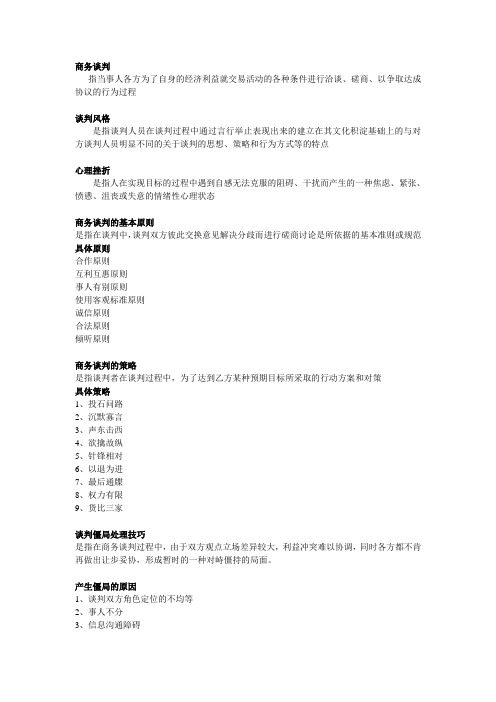
商务谈判指当事人各方为了自身的经济利益就交易活动的各种条件进行洽谈、磋商、以争取达成协议的行为过程谈判风格是指谈判人员在谈判过程中通过言行举止表现出来的建立在其文化积淀基础上的与对方谈判人员明显不同的关于谈判的思想、策略和行为方式等的特点心理挫折是指人在实现目标的过程中遇到自感无法克服的阻碍、干扰而产生的一种焦虑、紧张、愤懑、沮丧或失意的情绪性心理状态商务谈判的基本原则是指在谈判中,谈判双方彼此交换意见解决分歧而进行磋商讨论是所依据的基本准则或规范具体原则合作原则互利互惠原则事人有别原则使用客观标准原则诚信原则合法原则倾听原则商务谈判的策略是指谈判者在谈判过程中,为了达到乙方某种预期目标所采取的行动方案和对策具体策略1、投石问路2、沉默寡言3、声东击西4、欲擒故纵5、针锋相对6、以退为进7、最后通牒8、权力有限9、货比三家谈判僵局处理技巧是指在商务谈判过程中,由于双方观点立场差异较大,利益冲突难以协调,同时各方都不肯再做出让步妥协,形成暂时的一种对峙僵持的局面。
产生僵局的原因1、谈判双方角色定位的不均等2、事人不分3、信息沟通障碍4、心理障碍5、缺乏必要的策略和技巧6、外部环境发生变化7、人员素质低下谈判三要素:主体议题环境商务谈判的作用1、是企业实现经济目标的手段2、有利于促进商品经济的发展3、有利于企业获取市场信息的重要途径4、有利于加强企业间的经济联系5、是企业开拓市场的重要力量6、有利于促进我省对外贸易的发展谈判小组领导人的职责1、挑选谈判小组的成员2、制定一个周密的谈判计划3、总管谈判进程并对谈判中的具体问题做出决策4、做好谈判的汇报工作5、负责振奋大家的精神,使大家在任何情况下都能以高昂的士气参加谈判口头谈判优点1、灵活性大2、较好的表达谈判的目的3、谈判中情感性较强4、信息反馈性较强缺点1、易偏离主题2、主观性较强3、表达较为困难4、易产生谈判中和谈判后的纠纷5、费用较高运用1、首次接触的谈判2、相同或相近地区的谈判3、谈判周期较长的谈判4、大宗交易的谈判决定谈判队伍规模的因素1、谈判的复杂程度2、对专家的依赖程度3、可供运作谈判代表对人力资源状况4、谈判直接牵涉到的利益方的多少5、可供使用经费的多少6、谈判队伍负责人的管理控制能力一个人谈判的优点和缺点优点1、避免对方攻击已方势力较弱的成员2、避免多人参加的成员不协调3、谈判者客独自当机立断地采取对策4、成本低缺点1、一个人同时对付多方面的问题2、判断人员要单独做出对策,面临较大的压力3、某些谈判策略受到限制谈判小组领导人的职责1、挑选谈判小组的成员2、制定一个周密的谈判计划3、监管谈判进程并对谈判中的具体问题做出决策4、做好谈判的汇报工作5、负责振奋大家的精神,使大家在任何情况下都能以高昂的士气参加谈判、报价的先后艺术一般先由卖房报价先1、为谈判规定个框架,最终的协议将在这一界限内形成2、一定程度影响对方的期望水平进而影响对方的谈判行为后1、可能会使己方丧失一部分原本可以获得的利益2、会使对方集中力量对报价发起进攻,迫使报价方步步降价,而对方究竟打算出多高价却丝毫不露让步的基本准则1、确定让步的条件2、列出让步的清单3、制造出一种和谐的洽谈气氛4、制定心的磋商方案5、确定让步的方式6、选择合适的让步时机商务谈判中产生心理挫折的原因1、对谈判内容缺乏了解、信息掌握不够,制定出不合理、不可行的谈判目标2、由于惯例、经验、典范对谈判者的影响,形成思维定势和想法禁锢。
2024年商务谈判提纲总结

2024年商务谈判提纲总结一、背景介绍1.1 经济环境:全球经济持续增长,但面临一些不确定因素,如贸易摩擦和地缘政治风险。
1.2 企业背景:在这个快速变化的环境中,企业需要积极跟进市场趋势和技术变革,以满足客户需求。
1.3 商务谈判目的:通过商务谈判,达成一项有利于企业的合作协议,提升企业竞争力。
二、目标设定2.1 主要目标:确保合作协议能够实现双方利益最大化,建立长期战略合作伙伴关系。
2.2 具体目标:确保合作协议包括合理的商务条件、知识产权保护和技术支持等方面的内容。
三、谈判策略3.1 确定核心利益点:明确双方的核心利益点,以便在谈判过程中更好地把握关键议题。
3.2 建立信任关系:通过交流、沟通和理解对方的需求,建立互信关系,为后续谈判创造良好的氛围。
3.3 灵活变通:在谈判中保持灵活性,根据对方的反应和需求做出调整,并寻找双方利益的平衡点。
3.4 保持合作意愿:尽量避免采取强硬的立场,而是积极寻求合作和解决问题的方案。
四、谈判议程4.1 第一阶段:确定合作意愿和合作范围- 确定双方的合作意愿和共同目标- 确定合作范围和业务规模- 确定合作协议的时间框架和其他重要方面4.2 第二阶段:商务条件和合同条款的讨论- 商务条件的讨论,如价格、数量、交付方式等- 合同条款的讨论,如风险分担、违约责任等4.3 第三阶段:知识产权和技术支持的协商- 确定知识产权的保护措施和合作方式- 确定技术支持的模式,如培训、技术转让等4.4 第四阶段:协议草案的讨论和签署- 对合作协议的内容进行最后确认- 讨论协议草案的修改和完善- 签署合作协议五、谈判技巧5.1 倾听和理解:积极倾听对方的观点和需求,并试图理解其背后的逻辑。
5.2 主动提出问题:通过提出问题来引导对方更深入地叙述其观点和说法,并为自己获得更多信息。
5.3 控制情绪和语气:在谈判过程中保持冷静,并避免使用过激的语气,以免影响谈判氛围。
5.4 掌握谈判杠杆:了解自己和对方的利益点,把握谈判的主动权和节奏。
商务谈判复习纲要.doc
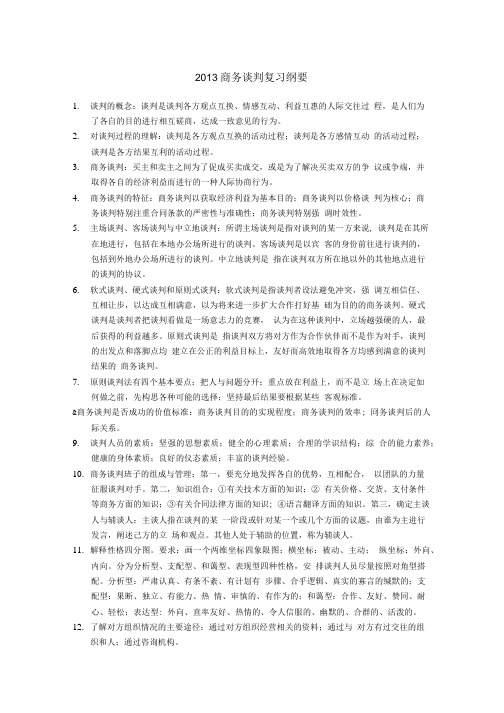
2013商务谈判复习纲要1.谈判的概念:谈判是谈判各方观点互换、情感互动、利益互惠的人际交往过程,是人们为了各自的目的进行相互磋商,达成一致意见的行为。
2.对谈判过程的理解:谈判是各方观点互换的活动过程;谈判是各方感情互动的活动过程;谈判是各方结果互利的活动过程。
3.商务谈判:买主和卖主之间为了促成买卖成交,或是为了解决买卖双方的争议或争端,并取得各自的经济利益而进行的一种人际协商行为。
4.商务谈判的特征:商务谈判以获取经济利益为基本目的;商务谈判以价格谈判为核心;商务谈判特别注重合同条款的严密性与准确性;商务谈判特别强调时效性。
5.主场谈判、客场谈判与中立地谈判:所谓主场谈判是指对谈判的某一方来说, 谈判是在其所在地进行,包括在本地办公场所进行的谈判。
客场谈判是以宾客的身份前往进行谈判的,包括到外地办公场所进行的谈判。
中立地谈判是指在谈判双方所在地以外的其他地点进行的谈判的协议。
6.软式谈判、硬式谈判和原则式谈判:软式谈判是指谈判者设法避免冲突,强调互相信任、互相让步,以达成互相满意,以为将来进一步扩大合作打好基础为目的的商务谈判。
硬式谈判是谈判者把谈判看做是一场意志力的竞赛,认为在这种谈判中,立场越强硬的人,最后获得的利益越多。
原则式谈判是指谈判双方将对方作为合作伙伴而不是作为对手,谈判的出发点和落脚点均建立在公正的利益目标上,友好而高效地取得各方均感到满意的谈判结果的商务谈判。
7.原则谈判法有四个基本要点:把人与问题分开;重点放在利益上,而不是立场上在决定如何做之前,先构思各种可能的选择;坚持最后结果要根据某些客观标准。
&商务谈判是否成功的价值标准:商务谈判目的的实现程度;商务谈判的效率; 冏务谈判后的人际关系。
9.谈判人员的素质:坚强的思想素质;健全的心理素质;合理的学识结构;综合的能力素养;健康的身体素质;良好的仪态素质;丰富的谈判经验。
10.商务谈判班子的组成与管理:第一,要充分地发挥各自的优势,互相配合,以团队的力量征服谈判对手。
商务谈判复习提纲

商务谈判复习提纲一、基本概念1、一场成功的谈判,每一方都是胜者。
2、谈判是一种合作,必须追求共同利益,才能使双方都得利。
3、谈判是有关组织(或个人)对涉及切身利益的分歧和冲突进行反复磋商,寻求解决途径和达成协议的过程。
4、任何一次商务谈判都必须具备三个要素。
5、商务谈判的内容可划分为投资谈判、商品供求谈判、技术引进与转让谈判。
6、商务谈判按性质划分可分为意向谈判、实务谈判、决定性谈判。
7、主体资格审查的核心,是检查商务谈判对方是否具有法人资格。
8、一个组织或个人具备了法律意义上的主题资格,但并不一定具备很强的行为能力。
9、在商务谈判前一般是根据最优期望目标、实际需求目标、可接受目标、最低目标四个层次来选择和确定洽谈目标。
10、在进行任何一次商务谈判时,都会感到时间的压力。
11、商务谈判的特点是利己和合作兼顾。
12、在商务谈判中希望进一步压制对方时可以使用制造竞争来达到目的。
13、商务谈判是指当事人各自为了自身的经济利益,就交易的各种进行洽谈、磋商,最终达成协议的过程。
14、商务谈判中的原则谈判法主张:坚持使用客观标准。
15、通常商务谈判者的心理活动受主观因素与客观因数的影响。
16、商务谈判中倾听可分为迎合式、引诱式、劝导式三种方式。
17、在商务谈判前一般是根据最优期望目标、实际需求目标、可接受目标、最低目标四个层次来选择和确定洽谈目标。
18、当商务谈判一方迫切希望进行商务谈判时,对于对方就是最佳谈判时机。
19、商务合同是一种法律行为,它建立的是商务谈判双方之间的法律关系。
二、应知应会问题:1、统筹型谈判的基本概念是什么?2、在商务活动中对对方的资信状况分析至少应包括那些内容?3、在商务活动中,如果双方产生分歧通常用哪几种方法对待?4、在商务谈判前,通常要做好那些心理准备?5、在确定商务谈判程序时,要注意哪些问题?6、涉外商务谈判中,一般受到那些法规制约?7、在商务谈判中如何坚持使用客观标准?8、在对商务谈判环境的情报主要那些内容?9、在商务活动中什么是加法报价法?10、涉外商务谈判中,一般受到那些法规制约?11、在商务谈判中常用的技巧有哪几种?12、商务谈判“倾听”有那几种功能效应?三、理论论述1、简述在商务谈判中什么是原则谈判法?2、简述商务谈判中运用思维跳跃技巧的作用?3、简述在商务谈判中常用几种争取时间的技巧4、简述成功说服的三步做法5、简述“移置心理”的表现;6、简述商务谈判中出现的拒绝相对性;7、简述在商务谈判中如何利用“合法”技巧;四、思考判断课本:P300—P307 (所有思考题)五、案例分析1、课本:P-312(五)分析航空公司采用了什么手段获得及其优惠用电价格。
- 1、下载文档前请自行甄别文档内容的完整性,平台不提供额外的编辑、内容补充、找答案等附加服务。
- 2、"仅部分预览"的文档,不可在线预览部分如存在完整性等问题,可反馈申请退款(可完整预览的文档不适用该条件!)。
- 3、如文档侵犯您的权益,请联系客服反馈,我们会尽快为您处理(人工客服工作时间:9:00-18:30)。
商务谈判复习提纲
题型:名词解释5道、判断10道、简答4道、实训2道、案例分析2道
1.商务谈判是指经济交往各方为了寻求和达到自身的经济利益目标,彼此进行交流、阐述意愿、磋商协议、协调关系并设法达成一致意见的行为过程。
2.商务谈判的作用:1.有利于促进市场经济的发展2.有利于实现企业的经济目标
3.有利于企业获取市场信息
4.有利于促进国际贸易发展。
3.谈判按谈判各方参加谈判的人员数量,分为大型谈判(各方在12人以上)、中型谈判(4~12人)、小型谈判(4人以下),或者分为小组谈判与单人谈判。
4.奥尔德弗ERG理论的核心观点:奥尔德弗认为,人同时存在三种需求,即存在的需求、关系的需求和成长的需求。
他同时提出了三个概念:需求满足、需求加强、需求受挫。
5开局阶段:开局是指参加谈判的各方人员,从开始谈判时第一次见面到正式讨论有关议题之间的一段时间。
6为什么要重利益、轻立场?
商务谈判中的双方处于不同的立场,双方立场的不同归根到底是由于双方的商业利益不同所造成的。
如果没有商业利益的纠缠,双方就没有谈判的必要。
如果在谈判中双方发生了冲突,最根本的动机只能是对各自商业利益的追求。
所以,谈判一定要紧紧围绕商业利益这个中心,要致力于解决双方在商业利益上的分歧,而不要仅仅纠缠于立场。
利益第一,立场第二,这是谈判桌面恒古不变的原则。
7谈判班子组成原则:1.规模要适当2.知识、能力要互补3.性格要互补
8模拟谈判:就是将谈判小组成员一分为二,或在谈判小组外,再建一个实力相当的谈判小组;由一方实施本方的谈判方案,另一方以对手的立场、观点和谈判作风为依据,进行实战操练、预演或彩排。
9.商务谈判开局阶段具体是指哪一段时间,在这一段时间要做什么。
商务谈判开局阶段,就是指谈判双方见面后,在进入具体交易内容讨论之前,相互介绍、寒暄以及就具体内容以外的话题进行交谈的阶段。
谈判者在开局阶段的主要任务就是为谈判营造一个适宜的气氛,谋求有利的开局地位,为后续的谈判打下良好的基础。
10.为什么要营造高调气氛?有哪些方法?
在高调气氛中,谈判对手往往只注意到他自己的有利方面,而且对谈判前景的看法也倾向于乐观,因此,高调气氛可以促进协议的达成。
营造高调气氛通常有以下几种方法:
(1)感情渲染法(2)称赞法(3)幽默法(4)诱导法
11.对买卖双方是不是报价越高越有利于谈判(×)
解析:在商务谈判中,谈判双方即买方与卖方处于对立统一体之中,它们既相互制约又相互统一。
因此报价水平的高低不是由报价一方随心所欲就可以决定的,报价只有在对方接受的情况下才可能产生预期的效果,才可能使买卖成交。
因此,谈判一方向另一方报价时,不能信口开河,而是要经过仔细分析、精心琉理,不仅要考虑报价所获利益,还要考虑该报价能否被对方接受,即报价能够成功的概率。
报价的基本原则:通过反复比较和权衡,设法找出报价者所得利益与该报价被接受的成功概率之间的最佳结合点。
12.根据报价的战术分,有欧式报价术与日式报价术。
13.什么是讨价还价?
讨价,是在一方报价之后,另一方认为其报价离己方的期望目标太远,而要求报价一方重新报价或改善报价的行为。
还价,就是针对谈判对手的首次报价,己方所做出的反应性报价。
还价以讨价作为基础。
在一方首先报价以后,另一方一般不会全盘接受,而是根据对手的报价,在经过几次讨价之后,
估计其保留价格和策略性虚报部分,推测对方可妥协的范围,然后根据己方的既定策略,提出自己可接受的价格,反馈给对方。
如果说报价划定了讨价还价范围的一个边界的话,那么,还价将划定与其对立的另一条边界;双方将在这两条边界所规定的界区内展开激烈的讨价还价。
14.所有出现谈判僵局一定要让步吗?
在商务谈判中坚持自己的主张、意见固然十分重要,但适度、适时的妥协也是极其必要的。
让步是为了避免谈判出现僵局。
当然,并不是什么都可以妥协,在原则问题上是不允许退让半步的。
15.什么是商务谈判僵局?
商务谈判僵局是指在商务谈判过程中,当双方对所谈问题的利益要求差距较大,各方又都不肯做出让步,导致双方因暂时不可调和的矛盾而形成对峙,而使谈判呈现出一种不进不退的僵持局面。
16.商务谈判僵局产生的原因。
(1)谈判一方故意制造谈判僵局。
(2)双方立场观点对立争执导致僵局。
(3)沟通障碍导致僵局。
(4)谈判人员的偏见或成见导致僵局。
(5)谈判人员的失误导致僵局。
(6)利益合理要求的差距导致僵局。
(7)其他原因导致僵局。
17.商务谈判僵局的处理原则。
(1)正确认识谈判的僵局。
(2)冷静的理性思考。
(3)协调好双方的利益。
(4)避免争吵。
(5)其他原则。
18.为圆满结束做出精心安排。
(1)回顾成果。
(2)弥合差异。
(3)澄清问题。
(4)对谈判低潮的把握。
19.情感渗透法。
1.甜言蜜语法
2.出其不意法
3.以情动人法
4.倾听与沉默法
20.巧打时间差法
1.时间战术
2.戒急用忍法
3.后发制人法。
